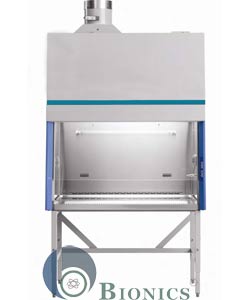Biosafety Cabinets - Knowing The Best For You
Class 2 Biosafety Cabinets – Vital for Lab Safety and Biological Containment

Modern laboratories prioritise safety for workers, materials, and environments. Whether it's handling live pathogens or sensitive diagnostics, biosafety cabinets are central to preventing cross-contamination and safeguarding personnel.
Of all types, Class 2 cabinets are most commonly used due to their efficiency and versatility. These units are indispensable tools for pathogen handling and biological research.
Overview of Biosafety Cabinets in Laboratory Environments
Biosafety cabinets are specially designed, enclosed systems that ventilate and filter lab air. They use advanced filters to trap harmful particles before air re-enters the lab.
These units are generally classified into three main types: Class I, II, and III based on containment level. Among these, Class 2 cabinets are the most versatile and commonly used.
What Are Class 2 Biosafety Cabinets?
Class 2 Biosafety Cabinets ensure safety on all fronts—personnel, workspace, and biological material. They direct filtered airflow in a laminar pattern over the work surface.
Contaminated air is drawn into the cabinet and filtered through HEPA systems before recirculation or exhaust. These cabinets are ideal for work involving moderate-risk pathogens (BSL-2/3).
Key Features of Microbiological Safety Cabinets
A Class 2 microbiological safety cabinet includes several advanced features such as:
• Medical-grade filters for capturing contaminants
• Steady air movement to reduce airborne particle circulation
• Inward airflow to keep aerosols contained
• Built-in UV sterilisation for decontaminating surfaces
• Low sound emissions to reduce fatigue
• Clear front panel for visibility and safety
These elements ensure safety, comfort, and efficiency in day-to-day lab tasks.
Industries and Labs That Rely on Microbiological Safety Cabinets
Class 2 Biosafety Cabinets are widely deployed in clinical labs, vaccine R&D, and academic research. They are ideal for safe handling of samples during testing and experimentation.
Whether in hospitals or drug manufacturing, these units are essential for clean procedures.
Advantages of Installing Class 2 Cabinets in Your Lab
Using Class 2 cabinets offers significant improvements in contamination control and user safety:
• Reduces the risk of sample cross-contamination and error
• Prevents accidental exposure to infectious materials
• Improves environmental safety by filtering outgoing air
These cabinets help labs meet safety regulations while maintaining workflow.
Regulatory Standards for Class 2 Cabinets
Top manufacturers design units compliant with major biosafety regulations worldwide. Class 2 units are sub-classified as A1, A2, B1, and B2—with each type offering different air handling systems.
• Type A2: Ideal for general-purpose labs
• Type B2: Exhausts 100% of air via ducting; no recirculation
Matching the cabinet type to your process is essential.
Tips for Purchasing the Ideal Biosafety Cabinet
Before purchasing, consider:
• Your application type (e.g., diagnostics, pharma, research)
• Ventilation compatibility and placement
• Energy consumption and maintenance frequency
• Service network and part availability
Consulting with experts ensures the cabinet fits both budget and compliance goals.
Safe Setup and Operation of Class 2 Cabinets
For optimal results:
• Minimise airflow interference during operation
• Ensure annual certification and airflow testing
• Train users in proper techniques and precautions
Operational best practices include:
• Use gloves, gowns, and face shields while operating
• Work calmly to prevent airflow disturbances
• Wipe work areas with disinfectants regularly
• Never activate UV when humans are present
Conclusion
Class 2 biosafety cabinets are a cornerstone of any safe, efficient laboratory. They ensure contamination-free experiments and personnel safety.
From biotech and diagnostics to academia and pharma, Class II cabinets copyright the highest biosafety Class 2 Biosafety Cabinets levels. When investing in a biosafety cabinet, opt for trusted brands that offer end-to-end service—because safe science starts with smart containment.